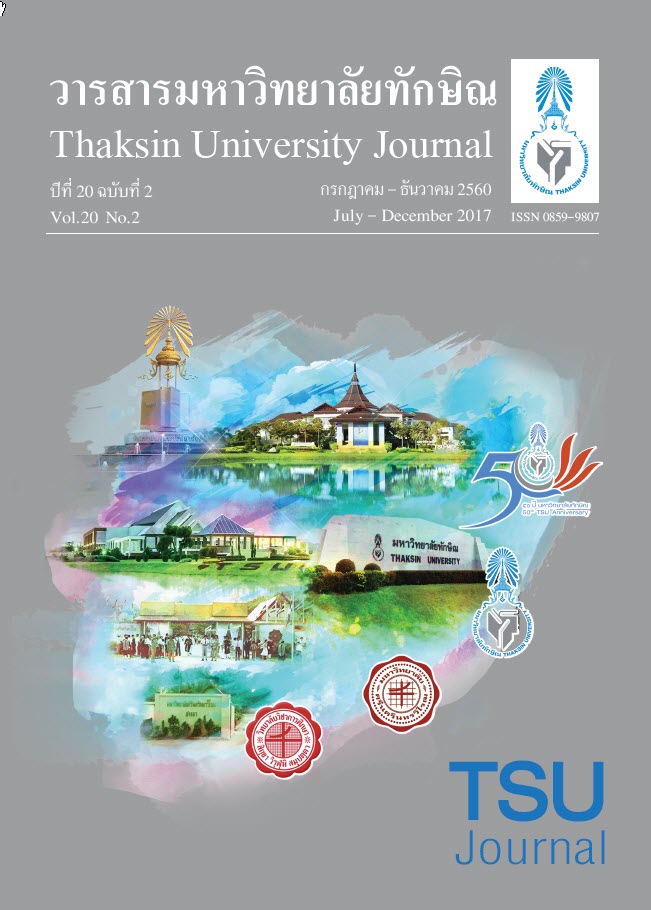การประยุกต์ใช้แผ่น PetrifilmTM Aerobic Count Plate ร่วมกับอาหารเลี้ยงเชื้อเหลว de Mann Rogasa Sharpe (MRS) เพื่อตรวจนับ แบคทีเรียกรดแลคติก
Main Article Content
บทคัดย่อ
การศึกษามีวัตถุประสงค์เพื่อประยุกต์ใช้แผ่นตรวจนับจุลินทรีย์ทั้งหมดที่ใช้ร่วมกับอาหารเลี้ยงเชื้อเหลว de Mann Rogasa Sharpe (MRS) เพื่อตรวจนับแบคทีเรียกรดแลคติกบริสุทธิ์ที่นำมาศึกษาจำนวน 4 ชนิด [Pediococcus pentosaceus 1 L14/1 (L14/1), Ped. acidilactici L25 (L25) Lactococcus lactis ssp. lactis 1 L26 (L26) และ Enterococcus faecium N15 (N15)] โดยเปรียบเทียบกับวิธีตรวจนับแบบการกระจายเชื้อ ด้วยการใช้ระดับเซลล์ตั้งต้น 1.5×108 เซลล์ต่อมิลลิลิตร รวมทั้งตัวอย่างจากนมหมักพบว่าวิธีการทั้ง 2 สามารถตรวจนับจำนวนแบคทีเรียกรดแลคติกที่นำมาศึกษาทุกชนิดได้ที่ระดับการเจือจาง 10-6 ไม่แตกต่างกันอย่างมีนัยสำคัญทางสถิติ (p < 0.05) แต่แตกต่างกันอย่างมีนัยสำคัญทางสถิติสำหรับผลิตภัณฑ์นมหมัก นอกจากนี้ยังพบว่าสามารถตรวจนับจำนวนแบคทีเรียกรดแลคติกต่ำสุดของL25L26และ N15 ได้ที่ระดับการเจือจาง 10-8 ในขณะที่สามารถตรวจนับจำนวนของแบคทีเรียกรดแลคติกต่ำสุดของ L14/1 ที่ระดับการเจือจาง 10-7 เมื่อตรวจนับด้วยวิธีการใช้แผ่นตรวจนับจุลินทรีย์ทั้งหมดร่วมกับอาหารเลี้ยงเชื้อเหลว MRS ซึ่งจะเห็นได้ว่าแผ่นตรวจนับจุลินทรีย์ทั้งหมดเมื่อใช้ร่วมกับอาหารเลี้ยงเชื้อเหลว MRS สามารถนำไปใช้ในเบื้องต้นเพื่อตรวจนับจำนวนแบคทีเรียกรดแลคติกบริสุทธิ
Article Details
References
perspective on a traditional therapy”, Clinical Infectious Disease. 32,1567-76.
[2] Roberfroid, M.B. (2000). Prebiotics and probiotics: are they functional foods? American Journal of Clinical
Nutrition. 71(Suppl), 1 682S-7S.
[3] Bellisle, F., Diplock A.T. and Hornstra, G. (1998). “Functional food science in Europe. British Journal of
Nutrition. 80(Suppl1), S3-4.
[4] Jain, S., Yadav, H. and Sinha. P.R. (2009). Antioxidant and cholesterol assimilation activities of selected
lactobacilli and lactococci cultures”, Journal Dairy Research. 76, 385-91.
[5] Jackson, T.G., Taylor, G.R.J., Clohessy, A.M. and William, C.M. (1999). The effects of the daily intake of
insulin on fasting lipid, insulin and glucose concentrations in middle-aged men and women. British
Journal of Nutrition. 89, 23-30.
[6] Garcia, C.T., Tabasco, R., Pelaez, C. and Requena, T. (2009). “Simultaneous detection and enumeration of
viable lactic acid bacteria and bifidobacteria in fermented milk by using propidium monoazide and
real-time PCR”, International of Dairy Journal. 19, 405-409.
[7] de Sousa, G.B., Tamagnini, L.M., Gonzalez, R.D. and Budde, C.E. (2005). “Evaluation of Petrifilm method
for enumerating aerobic bacteria in Crottin goat’s cheese”, Revista Argentina De Microbiologia.
37, 214-216.
[8] Gonçalves, M.M., Freitas, R., Nero, L.A. and Carvalho, A.F. (2009). “Enumeration of starter cultures
during yogurt production using Petrifilm AC plates associated with acidified MRS and M17 broths”,
Journal Dairy Research. 76, 229-233.
[9] Wu, S., Chouliara, E., Jensen, L.B. and Dalsgaard, A. (2008). “Evaluation of PetrifilmTM Select E. coli
Count Plate medium to discriminate antimicrobial resistant Escherichia coli”, Acta Veterinaria
Scandinavica. 50, 1-7.
[10] Interpretation Guide 3M PetrifilmTM Aerobic Count Plate Use for Growing Lactic Acid Bacteria. St. Paul,
MN, USA, nd, np.
[11] Lertcanawanichakul, M. (2005). “Isolation and selection of anti-Candida albicans producing lactic acid
bacteria”, Walailak Journal of Science & Technology. 2(2), 179-187.
[12] Suchira, G. (2002). Characterization and Antimicrobial Spectrum of Bacteriocin C3 Produced by Lactococcus
lactis C3. Thesis in Biopharmaceutical Science: Mahidol University, Bangkok : 105.
[13] Smet, D.I., Boever, P.D. and Verstraete, W. (1998). “Cholesterol lowering in pigs through enhanced
bacterial bile salt hydrolase activity”, British Journal of Nutrition. 79, 185-194.
[14] Losteinkit, C.H., Uchiyama, K.E., Ochi, S.H., Takaoka, T.O., Nagahisa, K.E. and Shioya, S.U. (2001).
“Characterization of bacteriocin N15 produced by Enterococcus faecium N15 and cloning of the
related genes”, Journal of Bioscience and Bioengineer. 91, 390-395.
[15] Ortolani, M.B., Viçosa, G.N., Beloti, V. and Nero, L.A. (2007). “Screening and enumeration of lactic acid
bacteria in milk using three different culture media in PAC and conventional pour plate methodology”,
Journal of Dairy Research. 74, 387-391.
[16] Champangne, C.P., Gardner, N., Piette, M. and Gelais, D.S. (2003). “The use of PetrifilmTM for the
Enumeration of Lactococci”, International Dairy Journal. 4, 789-795.
[17] Samarajeewa, A.D., Glasauer, S.M. and Dunfield, K.E. (2010). “Evaluation of Petrifilm EC method for
enumeration of E. coli from soil”, Letter of Applied Microbiology. 50, 457-461.

